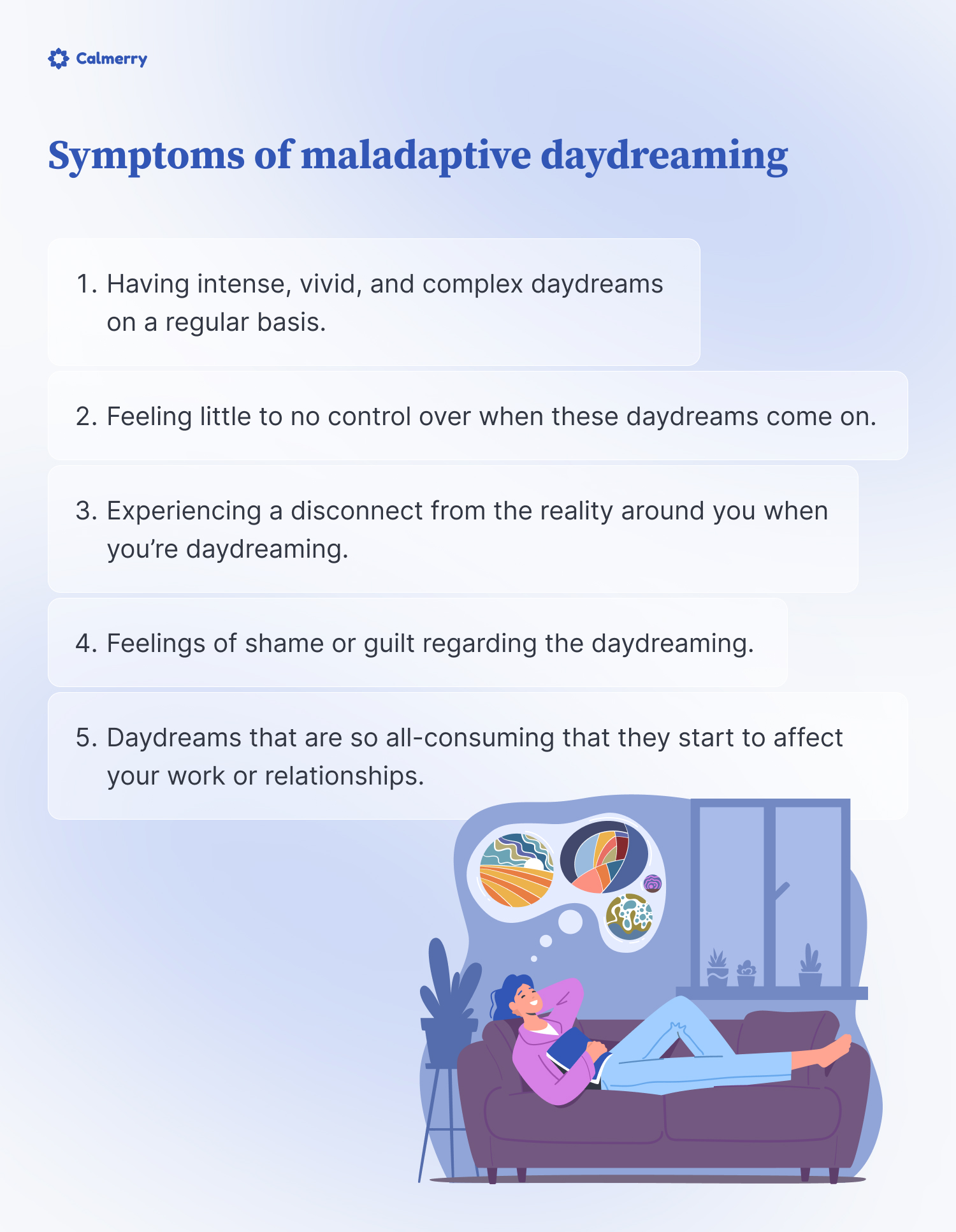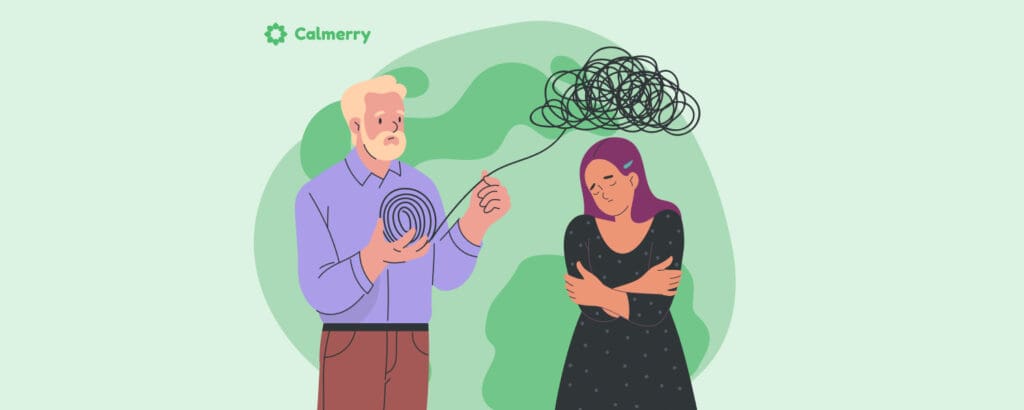What Is Maladaptive Daydreaming?

In this article
Have you ever gotten lost in your daydreams? Most of us have, especially as children. It’s fun to escape into a fantasy world sometimes, whether we’re daydreaming about the car of our dreams or someone we have a crush on.
For the most part, daydreaming is a harmless way to pass the time. But for some people, daydreaming can become an unhealthy coping mechanism. This is called maladaptive daydreaming; “maladaptive” means that it’s unhealthy and unhelpful.
People who are affected by maladaptive daydreaming may use their daydreams as a way to escape reality. Their daydreaming may become so intense and immersive that their real life and relationships start to suffer.
Maladaptive daydreaming isn’t a disorder on its own, although some experts argue that it should be. [1] Soffer‐Dudek, N., & Somer, E. (2018). Trapped in a daydream: Daily elevations in maladaptive daydreaming are associated with daily psychopathological symptoms. Frontiers in Psychiatry, 9. https://doi.org/10.3389/fpsyt.2018.00194 However, the medical community recognizes it as a common feature of many mental illnesses, including post-traumatic stress disorder.
In this article, we’ll discuss what maladaptive daydreaming is, what causes it, and how you can cope.
Symptoms of maladaptive daydreaming
Some signs that you may experience maladaptive daydreaming include:
- Having intense, vivid, and complex daydreams on a regular basis.
- Feeling little to no control over when these daydreams come on.
- Experiencing a disconnect from the reality around you when you’re daydreaming.
- Feelings of shame or guilt regarding the daydreaming.
- Daydreams that are so all-consuming that they start to affect your work or relationships.

Maladaptive daydreaming vs. regular daydreaming
The symptoms of maladaptive daydreaming can be categorized into two parts: symptoms that describe the daydreaming itself, and symptoms that describe how the person feels about the daydreaming. [2] Bigelsen, J., Lehrfeld, J. M., Jopp, D. S., & Somer, E. (2016). Maladaptive daydreaming: Evidence for an under-researched mental health disorder. Consciousness and Cognition, 42, 254–266. https://doi.org/10.1016/j.concog.2016.03.017
These are the 2 core features of maladaptive daydreaming that make it different from the ordinary type of daydreaming.
First, people who experience maladaptive daydreaming have daydreams that are very intense and detailed, much more so than ordinary daydreams. They may get lost in these vivid daydreams for up to hours at a time, and the daydreams have complex plot lines and characters – much like watching a movie in your mind.
Maladaptive daydreams are so vivid and intense that they can cause you to lose connection with reality. For example, you may not notice when someone is calling your name or miss an appointment because you didn’t keep track of the time. In this way, maladaptive daydreaming is much like dissociation.
Secondly, maladaptive daydreaming is characterized by how the daydreams affect the person. Maladaptive daydreaming typically ends with the person feeling badly – usually, guilty or ashamed – about the daydreaming.
In ordinary daydreams, you may feel happy or amused after “waking up.” But for maladaptive daydreamers, there is nothing happy about getting lost in the daydream. People typically feel embarrassed by the idea that they lost so much time to daydreaming.
Similar to compulsive behavior, people who experience maladaptive daydreaming have little to no control over it. It’s not something fun you do to pass the time – it’s a compulsive behavior that you do even when you don’t want to. Just like an addiction, you may have tried to stop daydreaming, only to be unsuccessful in your attempts.
– Saya Des Marais, MSW, Therapist-turned-mental health writer
Maladaptive daydreaming can also be very detrimental to your functioning. Typical or healthy daydreaming can be just a way to pass the time or use your imagination. But maladaptive daydreaming starts to cause serious problems in your life, like at work or in your relationships.
Causes of maladaptive daydreaming
Experts still don’t know what, exactly, causes maladaptive daydreaming.
In general, people who experience maladaptive daydreaming are trying to get away from reality in some way. You may not have a conscious desire to daydream – in fact, you may even try to resist the urge – but your brain engages in this compulsive behavior.
Others lose themselves in their daydreams intentionally.
Is maladaptive daydreaming a trauma response?
Maladaptive daydreaming is not always related to trauma, but it can be. Maladaptive daydreaming is a coping response rooted in dissociation, or disconnecting from reality because it feels too overwhelming.
One multi-national study found that people who had experienced childhood trauma were much more likely to use daydreaming as an emotional coping strategy. [3] Somer, E., Abu-Rayya, H. M., & Brenner, R. (2020). Childhood Trauma and Maladaptive Daydreaming: Fantasy Functions and Themes in a Multi-Country sample. Journal of Trauma & Dissociation, 22(3), 288–303. https://doi.org/10.1080/15299732.2020.1809599 Childhood abuse survivors were more likely to daydream about idealized versions of their families but also experienced themes of death, violence (as the victim), and other morbid daydreams.
However, it’s important to note that you can be affected by maladaptive daydreaming even if you haven’t survived trauma.
Associated conditions with maladaptive daydreaming
Some people who live with certain mental health conditions may be more likely to experience maladaptive daydreaming. Some symptoms of other mental health disorders can be confused with maladaptive daydreaming.
Maladaptive daydreaming and post-traumatic stress disorder (PTSD)
People who’ve experienced trauma often want to avoid thinking about the traumatic event. In fact, avoidance of thoughts, places, people, and things that remind you of the event is a core symptom of PTSD.
Maladaptive daydreaming is sometimes a way for people who’ve gone through trauma to avoid thinking about it.
Maladaptive daydreaming and attention-deficit hyperactivity disorder (ADHD)
Studies have shown that around 75% of people who experience maladaptive daydreaming also meet the criteria for ADHD. [4] Somer, E., Soffer‐Dudek, N., & Ross, C. A. (2017). The Comorbidity of daydreaming Disorder (Maladaptive Daydreaming). The Journal of Nervous and Mental Disease, 205(7), 525–530. https://doi.org/10.1097/nmd.0000000000000685
Maladaptive daydreaming can make someone seem “spacey” or distracted, which can look almost identical to the inattentive type of ADHD.
However, new research suggests that maladaptive daydreaming and ADHD are two distinct problems. [5] Theodor‐Katz, N., Somer, E., Hesseg, R. M., & Soffer‐Dudek, N. (2022). Could immersive daydreaming underlie a deficit in attention? The prevalence and characteristics of maladaptive daydreaming in individuals with attention‐deficit/hyperactivity disorder. Journal of Clinical Psychology, 78(11), 2309–2328. https://doi.org/10.1002/jclp.23355
Maladaptive daydreaming and autism
Research has shown a clear link between autism and maladaptive daydreaming – one study found that over 40% of autistic people had experiences of maladaptive daydreaming. [6] West, M. J., Somer, E., & Eigsti, I. (2022). Shared challenges and cooccurrence of maladaptive daydreaming and autism spectrum disorder. Advances in Neurodevelopmental Disorders, 7(1), 77–87. https://doi.org/10.1007/s41252-022-00279-1
The study also found that both autistic people and people who experience maladaptive daydreaming scored higher for loneliness and difficulties with emotional regulation, so these factors could explain the link.
Maladaptive daydreaming and obsessive-compulsive disorder (OCD)
Some research has found links between maladaptive daydreaming and OCD because of the obsessive nature of the daydreaming. [7] Salomon-Small, G., Somer, E., Harel-Schwarzmann, M., & Soffer‐Dudek, N. (2021). Maladaptive Daydreaming and Obsessive-Compulsive Symptoms: A confirmatory and exploratory investigation of shared mechanisms. Journal of Psychiatric Research, 136, 343–350. https://doi.org/10.1016/j.jpsychires.2021.02.017 Just like it feels impossible for people with OCD to stop performing compulsions, it feels just as impossible for others to stop maladaptive daydreaming.
In addition, maladaptive daydreaming can become a compulsion for some people with OCD.
Maladaptive daydreaming vs. dissociation
Dissociation is a category of mental health disorders that causes someone to have a partial or complete disconnect from reality. Maladaptive daydreaming can be a type of dissociative coping, or a way to cut yourself off from the world around you (as well as – in many cases – your internal life).
However, people with dissociative disorders typically have a much more severe break from reality. For example, people with dissociative identity disorder experience alternate personalities that take over when situations become too overwhelming for the original personality.
The disconnect typically isn’t as severe for people who experience maladaptive daydreaming.
Maladaptive daydreaming vs. schizophrenia
Schizophrenia is another mental illness that can cause people to experience a break from reality. Schizophrenia is a psychotic disorder that leads to delusions (believing things that aren’t rooted in reality) and hallucinations (seeing, hearing, or otherwise sensing things that aren’t really there).
Maladaptive daydreaming is not the same thing as schizophrenia, because frequent daydreamers are aware that their daydreams are not reality. People with schizophrenia, on the other hand, may have more difficulty distinguishing their hallucinations and delusions from reality.
Maladaptive daydreaming test
Since there is no official diagnosis for maladaptive daydreaming, there is also no official diagnostic tool to test for it.
However, researchers have created the Maladaptive Daydreaming Scale, or the MDS-16, to determine whether someone may experience maladaptive daydreaming and to what extent. [8] 16-Item maladaptive daydreaming scale. (n.d.). https://psycnet.apa.org/doiLanding?doi=10.1037%2Ft84726-000 This tool includes 16 items you rate on a Likert scale, including questions about what triggers your daydreams, how intense they are, and how daydreaming affects your life.
If you’re concerned you may be experiencing maladaptive daydreaming, talk to a licensed mental health provider. They can provide more information about what you may be going through.
How to deal with maladaptive daydreaming
On the surface level, it could seem like maladaptive daydreaming isn’t that damaging. What harm could come from escaping into a fantasy world?
However, the truth about maladaptive daydreaming is very different. Maladaptive daydreaming is not the ordinary and common type of daydreaming (which most people do on occasion). People who experience maladaptive daydreaming get lost in daydreams whether they want to or not. This can have severely negative effects on their lives.
However, there are ways to cope with maladaptive daydreaming, and treatment can help. Here are some simple tips.
Practice mindfulness
Mindfulness is a powerful tool to ground yourself in the here and now. Find ways to incorporate practices like deep breathing exercises, body scans, or guided meditations into your daily routine.
These methods not only redirect your focus away from excessive daydreaming, but can also bring you back to the present moment. Mindfulness also empowers you to observe your thoughts without judgment, which can create a healthier relationship with your inner world.
To enhance the effectiveness of mindfulness, consider integrating it into specific moments of your day, like during transitions between activities or when you feel the urge to daydream.
Limit triggers
Identifying and minimizing your triggers is very important in managing maladaptive daydreaming.
Take a good look at your surroundings.
What are the triggers that tend to fuel your daydreaming tendencies?
Are they certain genres of books, movies, or specific types of music?
Are there certain moments in your day that you’re more likely to fall into maladaptive daydreaming?
Once you’ve identified your triggers, take intentional steps to limit your exposure to them. For example, you might create a designated space in your home free from potential triggers or try moving towards less triggering sources of entertainment.
Engage in creative outlets
Channeling your imagination into creative outlets could also be a constructive way to redirect your focus away from your daydreams. Whether it’s through writing, drawing, or other forms of artistic expression, engaging in creative activities can be a healthier way to channel the thoughts that lead to daydreams.
Try focusing on creative activities that bring you a sense of fulfillment. By transforming daydreaming into a purposeful and expressive activity, you not only manage the “maladaptive” tendencies but also cultivate a more positive and enriching relationship with your inner world.
Get treatment
Because maladaptive daydreaming isn’t recognized as a mental health condition on its own, there is no standard treatment available for it yet. One case study found that fluvoxamine – a medication that’s typically used to treat OCD – was helpful for a patient with maladaptive daydreaming. [9] Schupak, C., & Rosenthal, J. (2009). Excessive daydreaming: A case history and discussion of mind wandering and high fantasy proneness. Consciousness and Cognition, 18(1), 290–292. https://doi.org/10.1016/j.concog.2008.10.002 But we need more research to know for sure.
However, psychotherapy could have many benefits for people who experience maladaptive daydreaming. Working with a therapist can help you discover what could be contributing to maladaptive daydreaming for you and figure out how you can cope in healthier ways.
A word from Calmerry
Maladaptive daydreaming can be very disruptive and cause you to miss out on important aspects of your real waking life.
Although there’s not yet a standard treatment for maladaptive daydreaming, working with a therapist can help. Therapists can also offer treatment for mental health conditions that are associated with maladaptive daydreaming, like OCD or ADHD.
At Calmerry, we have many licensed psychotherapists who can help you cope with maladaptive daydreaming and provide treatment for the mental health conditions that could be causing it.
Maladaptive daydreaming no longer needs to interfere with your life. Try online therapy with Calmerry today!
Soffer‐Dudek, N., & Somer, E. (2018). Trapped in a daydream: Daily elevations in maladaptive daydreaming are associated with daily psychopathological symptoms. Frontiers in Psychiatry, 9. https://doi.org/10.3389/fpsyt.2018.00194
Bigelsen, J., Lehrfeld, J. M., Jopp, D. S., & Somer, E. (2016). Maladaptive daydreaming: Evidence for an under-researched mental health disorder. Consciousness and Cognition, 42, 254–266. https://doi.org/10.1016/j.concog.2016.03.017
Somer, E., Abu-Rayya, H. M., & Brenner, R. (2020). Childhood Trauma and Maladaptive Daydreaming: Fantasy Functions and Themes in a Multi-Country sample. Journal of Trauma & Dissociation, 22(3), 288–303. https://doi.org/10.1080/15299732.2020.1809599
Somer, E., Soffer‐Dudek, N., & Ross, C. A. (2017). The Comorbidity of daydreaming Disorder (Maladaptive Daydreaming). The Journal of Nervous and Mental Disease, 205(7), 525–530. https://doi.org/10.1097/nmd.0000000000000685
Theodor‐Katz, N., Somer, E., Hesseg, R. M., & Soffer‐Dudek, N. (2022). Could immersive daydreaming underlie a deficit in attention? The prevalence and characteristics of maladaptive daydreaming in individuals with attention‐deficit/hyperactivity disorder. Journal of Clinical Psychology, 78(11), 2309–2328. https://doi.org/10.1002/jclp.23355
West, M. J., Somer, E., & Eigsti, I. (2022). Shared challenges and cooccurrence of maladaptive daydreaming and autism spectrum disorder. Advances in Neurodevelopmental Disorders, 7(1), 77–87. https://doi.org/10.1007/s41252-022-00279-1
Salomon-Small, G., Somer, E., Harel-Schwarzmann, M., & Soffer‐Dudek, N. (2021). Maladaptive Daydreaming and Obsessive-Compulsive Symptoms: A confirmatory and exploratory investigation of shared mechanisms. Journal of Psychiatric Research, 136, 343–350. https://doi.org/10.1016/j.jpsychires.2021.02.017
16-Item maladaptive daydreaming scale. (n.d.). https://psycnet.apa.org/doiLanding?doi=10.1037%2Ft84726-000
Schupak, C., & Rosenthal, J. (2009). Excessive daydreaming: A case history and discussion of mind wandering and high fantasy proneness. Consciousness and Cognition, 18(1), 290–292. https://doi.org/10.1016/j.concog.2008.10.002
online therapy
live video session



